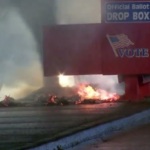As Russia continues to grapple with consecutive drone attacks, attributed to the Ukrainian military, the nation finds itself reeling from the aftermath of what it considers its most significant strike on its soil – one that caused the destruction of four Ilyushin IL-76 military transport planes.
In the attack that occurred over the Pskov Oblast of Russia, state media reported in the early hours of August 30th that at least four Ilyushin IL-76 military transport planes had been damaged, with subsequent confirmation of UAV strikes over the Kresty airfield.
The initial official communication came from Mikhail Vedernikov, the regional governor of Pskov, who reported that the Pskov airfield was dealing with the aftermath of the “drone attack” as he shared visuals of an explosion and a significant fire. Sources indicated that the attack resulted in fires aboard the Il-76 military aircraft.
The governor later remarked, “I am at the scene from the beginning of the event. Preliminary reports suggest no casualties. The extent of damage is being assessed.” However, an accurate assessment of the damage caused by the fire in the Ilyushin-76 could not be independently confirmed by the Ural Times.
Situated near the Estonian border, Pskov is over 600 kilometers (372 miles) away from the Ukrainian border. While Kyiv rarely comments on strikes within Russia, it hasn’t denied involvement in this latest attack that has rattled the Kremlin.
The drone attacks stand out as the most significant of their kind on Russian soil, as confirmed by the Russian Ministry of Defense (MOD), which indicated that Ukrainian drones targeted at least six Russian regions.
Following the collision with a local airfield in Western Pskov, the drones were reportedly downed in Moscow, Oryol, Bryansk, Ryazan, and Kaluga. As a precaution, Mikhail Vedernikov issued orders to cancel all flights to and from the airport during the day while the damage was assessed.
Social media posts and videos also depict fierce fires and plumes of smoke over Pskov. According to Vedernikov, no casualties were reported, and the fires were extinguished. Despite rumors, media reports were unable to independently confirm whether ten to twenty drones targeted the airport.
In response to the drone attacks, the major airports outside Moscow – Sheremetyevo, Vnukovo, and Domodedovo – temporarily grounded all incoming and outgoing flights. However, Moscow’s retaliatory action in response to the Pskov attack isn’t surprising. The city launched a large number of martyr drones over Kyiv, considered the most significant strike since the spring, followed by targeting drones using the Tu-95MS strategic bomber.
Recognizing the utility of military transport aircraft during wartime, Moscow’s aggressive military response isn’t unexpected. The IL-76, an aging yet practical medium-range military transport aircraft, is tasked with carrying paratroopers, medium-sized combat tanks, driver teams, and troops along with combat equipment and cargo airlift for military units.
Drone Strike By Ilyushin Il-76 Air-Craft :-
The first aircraft of its kind was introduced to the Soviet Air Force in June 1974, and it has since become a backbone of Russian military transport. Deployed in various combat zones, including Afghanistan and Syria, it’s an aircraft well-recognized within the Russian sphere, and its legacy extends to Ukraine as well.
Losing such aircraft in the fires could prove to be a significant setback for the Russian military, given that the planes would be inside repair hangars, even if not completely destroyed.
With that said, while Ukraine claimed responsibility for removing Russian military aircraft, Moscow retaliated on the same day by destroying a substantial number of Ukrainian naval boats.
Drone Strike By Ukraine but Russia Destroyed Four Ukrainian Military Boats :-
The Russian Defense Ministry acknowledged on August 30th that it targeted at least four Ukrainian naval boats carrying a minimum of 50 personnel of the Ukrainian Special Operations Force and destroyed them in the Black Sea. According to the ministry’s Telegram messaging app, around midnight [21:00 GMT], an aircraft carried out an attack “on four high-speed Ukrainian naval boats.” The ministry said that the boats were transporting landing groups of Ukrainian Special Operations Forces, which numbered up to 50 personnel. However, it’s not clear where the incident occurred in the Black Sea.
The TASS agency of Russia reported that drone boats attempted to attack the coast of Sevastopol on the Crimean Peninsula. However, they were successfully repelled by the amphibious assault forces.
Mikhail Razvozhayev, the appointed governor of Moscow, stated that Russian security forces successfully repelled an “attempted successful drone attack” near the coast of the Sevastopol Gulf in Crimea, a region that Russia annexed in 2014, turning it into a headquarters for its Black Sea Fleet. Razvozhayev added, without providing further details, that “the amphibious assault…forces have done their job.”
In recent weeks, drone attacks over Crimea have escalated. Drones have targeted fuel depots and airfields, with Russian officers attributing them to Kyiv. However, Ukrainian officials have refrained from explicitly claiming their responsibility while tacitly acknowledging their role.
Another Post Links :-
https://onworldsnews.com/world-cup-kiss-controversy-spanish-football/














